人教版(2019)选择性必修第一册 (2)Unit 4 Body Language Reading and Thinking 课件(共16张PPT)
文档属性
| 名称 | 人教版(2019)选择性必修第一册 (2)Unit 4 Body Language Reading and Thinking 课件(共16张PPT) | 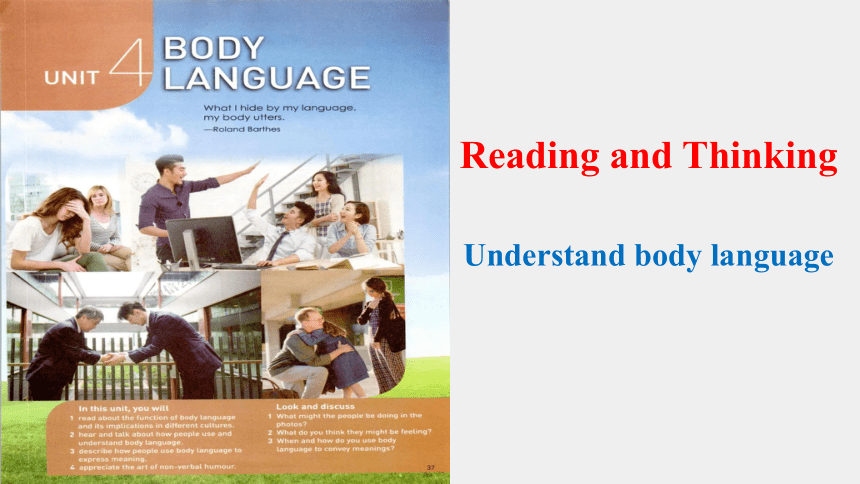 | |
| 格式 | pptx | ||
| 文件大小 | 16.9MB | ||
| 资源类型 | 教案 | ||
| 版本资源 | 人教版(2019) | ||
| 科目 | 英语 | ||
| 更新时间 | 2024-09-10 23:09:29 | ||
图片预览

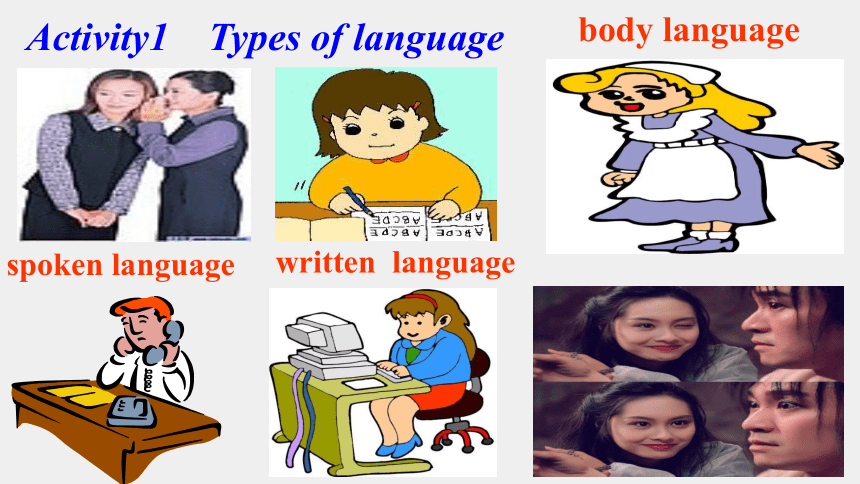
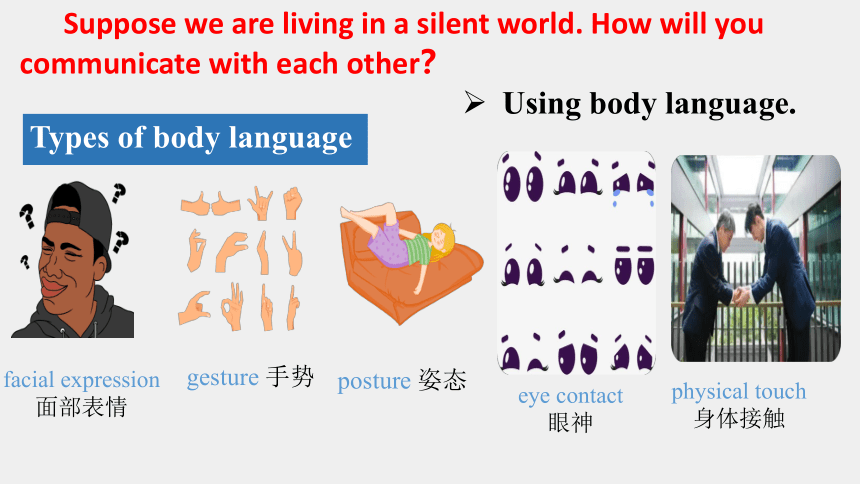
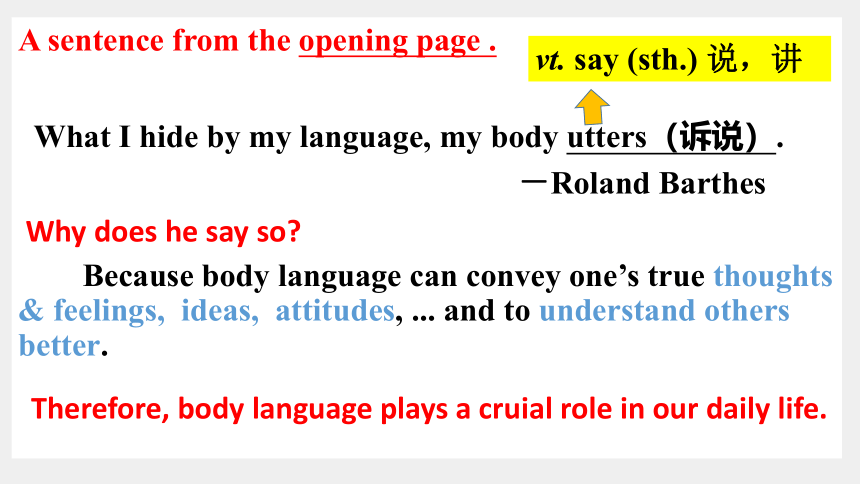
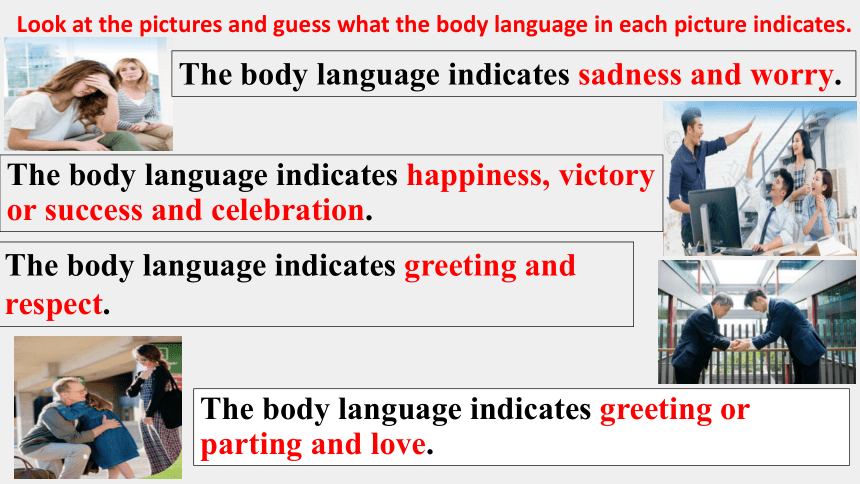
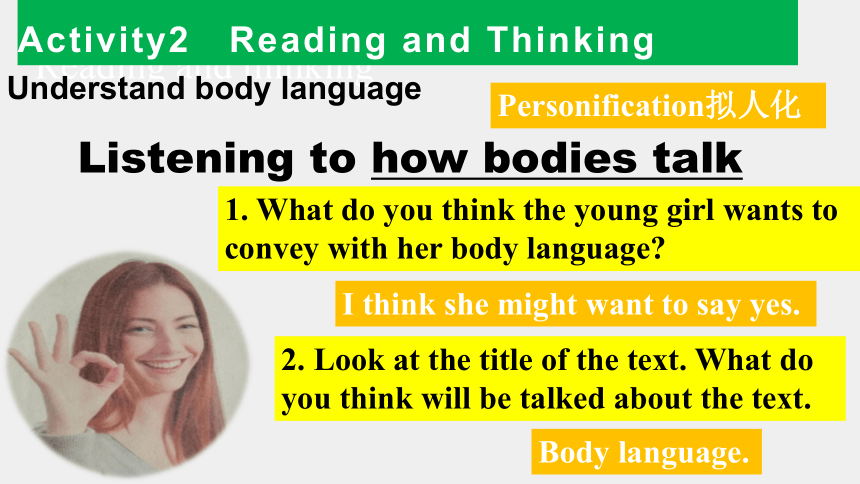
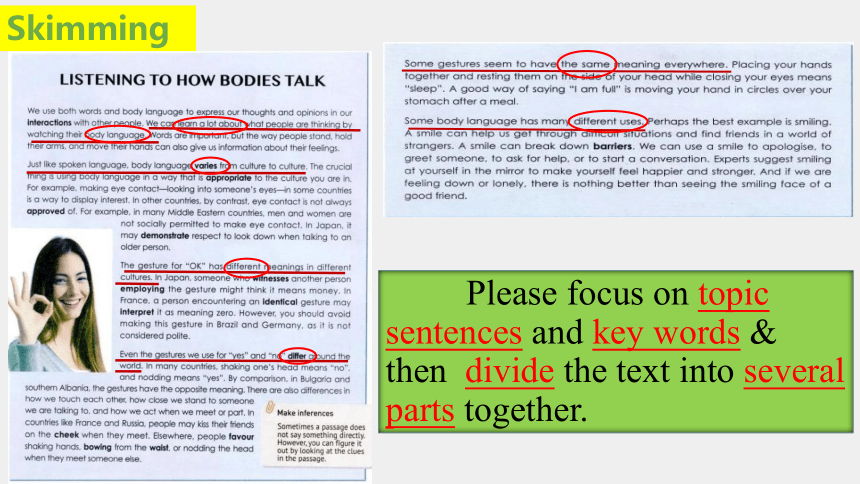
文档简介
(共16张PPT)
Reading and Thinking
Understand body language
spoken language
written language
body language
Activity1 Types of language
Suppose we are living in a silent world. How will you communicate with each other?
Using body language.
Types of body language
posture 姿态
facial expression
面部表情
gesture 手势
eye contact
眼神
physical touch
身体接触
A sentence from the opening page .
What I hide by my language, my body utters(诉说).
-Roland Barthes
Why does he say so
Because body language can convey one’s true thoughts & feelings, ideas, attitudes, ... and to understand others better.
Therefore, body language plays a cruial role in our daily life.
vt. say (sth.) 说,讲
The body language indicates sadness and worry.
The body language indicates happiness, victory or success and celebration.
The body language indicates greeting and respect.
The body language indicates greeting or parting and love.
Look at the pictures and guess what the body language in each picture indicates.
Listening to how bodies talk
Reading and thinking
Activity2 Reading and Thinking
1. What do you think the young girl wants to convey with her body language
I think she might want to say yes.
Personification拟人化
Understand body language
2. Look at the title of the text. What do you think will be talked about the text.
Body language.
Please focus on topic sentences and key words & then divide the text into several parts together.
Skimming
The passage can be divided into _____ parts. Fill in each blank with a key word to complete the main idea of each part.
Para. Main idea
Part 1 ____________ to body language: ______________ and
__________of body language.
Part 2 Body language with _________meanings in __________ cultures.
Part 3 Body language with the ________ meaning everywhere
Part 4 Body language with ___________ uses
Introduction
importance
different
different
same
different
four
function
(Para.1)
(Para. 2-4)
(Para. 5 )
(Para. 6)
Para2 varies
para4 differ
Para3 different
Differences
Similarities
Different uses
Introduction
Structure
Part 1 (Para1)
Introduction to body language
Part 2 (Para2-4)
Topic sentence Supporting idea 1 (contrast)
Supporting idea 2
Part 3 (Para 5)
Part 4 (Para 6)
Topic sentence
Supporting idea 1 (identical)
Supporting idea 2
Topic sentence
Supporting idea
1-9
(identical)
总general
|
分specific
1. What does the word “interaction” in the first sentence in Paragraph 1 means
A.exchange B.Relationship C.Communication D. Reaction
2. What is the main idea of the text
A.The cultural differences of body language.
B.The differences between body language and spoken language.
C.The characteristics of body language.
D. Body language in different cultures
3. What is the type of the passage
Scanning
A. A narration
C. An exposition
B. An argumentation
D. An application
4. How is the passage developed
A. By giving data
C. By giving examples
B. By making comparisons
D. By giving definitions
5. Which statement does the author possibly agree with
A. Never too old to learn.
B. Four eyes see more than two.
C. Action speaks louder than words.
D. When in Rome, do as the Romans do.
Body language/Gesture Meaning Country/Region
Eye contact between men & women Not polite Middle East
Looking down when talking to someone
OK sign
Placing your hands together and resting them on the side of your head while closing your eyes
Detailed reading with listening (Para2-5)
Japan
A sign of respect
Japan
Money
France
Zero
Brazil/Germany
Not polite
China
Yes
kiss on the cheek
to greet someone
France & Russia
Many countries
Bulgaria & Southern Albania
no
yes
shake the head
I’m sleepy.
Moving your hand in circles over your stomach after a meal
most places
I’m full
GW Discussion
A. Talk about the bodylanguage you like best
B. Offer some advice to your penpal Mark, an American, on 3 occasions in China:
1. when meeting people for the first time
2. when talking to others
3. when sitting or standing
GW Talk about the body language you like best
Smile costs nothing, but gives too much:
get through difficult situations, find friends, break down barriers, apologise, greet someone, ask for help, start a conversation, feel happier and stronger, get comforted, show confidence, hide the embarrassment,…(Para6)
It is a universal language everybody needs & likes!
In China, when we sit or stand, we’d better not
____________________ or
______________________ .
B. Offer some advice to your penpal Mark, an American,on 3 occasions in China:
In China,when people meet, it is proper for us to _______________________ rather than_____________________________, and keep _________________.
shake hands with others
kiss on the hand or the cheek
a proper distance
In China, it’s good manners to______________
and have_____________ when talking to others.
keep smiling
eye contact
sit with crossed legs
stand with crossed arms
Homework
1. Act out the body language below to your partner(P38,Task1).
2. Finish Uint4 of English Weekly
Reading and Thinking
Understand body language
spoken language
written language
body language
Activity1 Types of language
Suppose we are living in a silent world. How will you communicate with each other?
Using body language.
Types of body language
posture 姿态
facial expression
面部表情
gesture 手势
eye contact
眼神
physical touch
身体接触
A sentence from the opening page .
What I hide by my language, my body utters(诉说).
-Roland Barthes
Why does he say so
Because body language can convey one’s true thoughts & feelings, ideas, attitudes, ... and to understand others better.
Therefore, body language plays a cruial role in our daily life.
vt. say (sth.) 说,讲
The body language indicates sadness and worry.
The body language indicates happiness, victory or success and celebration.
The body language indicates greeting and respect.
The body language indicates greeting or parting and love.
Look at the pictures and guess what the body language in each picture indicates.
Listening to how bodies talk
Reading and thinking
Activity2 Reading and Thinking
1. What do you think the young girl wants to convey with her body language
I think she might want to say yes.
Personification拟人化
Understand body language
2. Look at the title of the text. What do you think will be talked about the text.
Body language.
Please focus on topic sentences and key words & then divide the text into several parts together.
Skimming
The passage can be divided into _____ parts. Fill in each blank with a key word to complete the main idea of each part.
Para. Main idea
Part 1 ____________ to body language: ______________ and
__________of body language.
Part 2 Body language with _________meanings in __________ cultures.
Part 3 Body language with the ________ meaning everywhere
Part 4 Body language with ___________ uses
Introduction
importance
different
different
same
different
four
function
(Para.1)
(Para. 2-4)
(Para. 5 )
(Para. 6)
Para2 varies
para4 differ
Para3 different
Differences
Similarities
Different uses
Introduction
Structure
Part 1 (Para1)
Introduction to body language
Part 2 (Para2-4)
Topic sentence Supporting idea 1 (contrast)
Supporting idea 2
Part 3 (Para 5)
Part 4 (Para 6)
Topic sentence
Supporting idea 1 (identical)
Supporting idea 2
Topic sentence
Supporting idea
1-9
(identical)
总general
|
分specific
1. What does the word “interaction” in the first sentence in Paragraph 1 means
A.exchange B.Relationship C.Communication D. Reaction
2. What is the main idea of the text
A.The cultural differences of body language.
B.The differences between body language and spoken language.
C.The characteristics of body language.
D. Body language in different cultures
3. What is the type of the passage
Scanning
A. A narration
C. An exposition
B. An argumentation
D. An application
4. How is the passage developed
A. By giving data
C. By giving examples
B. By making comparisons
D. By giving definitions
5. Which statement does the author possibly agree with
A. Never too old to learn.
B. Four eyes see more than two.
C. Action speaks louder than words.
D. When in Rome, do as the Romans do.
Body language/Gesture Meaning Country/Region
Eye contact between men & women Not polite Middle East
Looking down when talking to someone
OK sign
Placing your hands together and resting them on the side of your head while closing your eyes
Detailed reading with listening (Para2-5)
Japan
A sign of respect
Japan
Money
France
Zero
Brazil/Germany
Not polite
China
Yes
kiss on the cheek
to greet someone
France & Russia
Many countries
Bulgaria & Southern Albania
no
yes
shake the head
I’m sleepy.
Moving your hand in circles over your stomach after a meal
most places
I’m full
GW Discussion
A. Talk about the bodylanguage you like best
B. Offer some advice to your penpal Mark, an American, on 3 occasions in China:
1. when meeting people for the first time
2. when talking to others
3. when sitting or standing
GW Talk about the body language you like best
Smile costs nothing, but gives too much:
get through difficult situations, find friends, break down barriers, apologise, greet someone, ask for help, start a conversation, feel happier and stronger, get comforted, show confidence, hide the embarrassment,…(Para6)
It is a universal language everybody needs & likes!
In China, when we sit or stand, we’d better not
____________________ or
______________________ .
B. Offer some advice to your penpal Mark, an American,on 3 occasions in China:
In China,when people meet, it is proper for us to _______________________ rather than_____________________________, and keep _________________.
shake hands with others
kiss on the hand or the cheek
a proper distance
In China, it’s good manners to______________
and have_____________ when talking to others.
keep smiling
eye contact
sit with crossed legs
stand with crossed arms
Homework
1. Act out the body language below to your partner(P38,Task1).
2. Finish Uint4 of English Weekly
